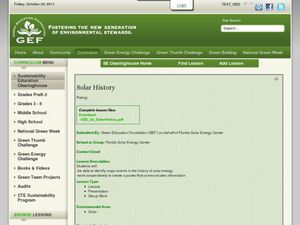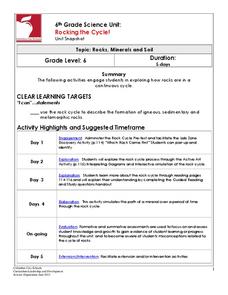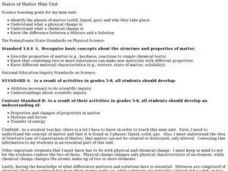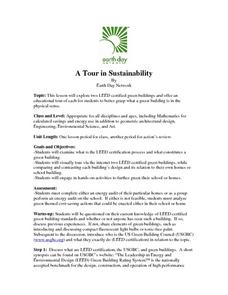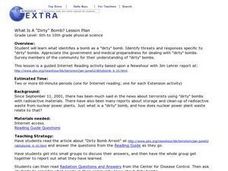Curated OER
Mammals
Students gather information from an online database about mammals. Choosing one mammal, they compare its physical characteristics, food habits, behavior and location to the other mammals they were introduced to in this lesson. In groups,...
Curated OER
See the light
How do light and eyesight function? Read a brief passage explaining the phenomena of light and sight. Then have learners draw arrows showing how a boy in a room with a lamp would be able to see a chair. A mini-experiment suggestion is...
Curated OER
Mixing Colors
In this science worksheet, students drop food coloring into a glass of water. Students mix different colors to create new colors.
Curated OER
Prairie Plant Investigation
Students carefully observe prairie plants and record their observations in a science journal. They examine the root systems of grasses and flowers and surmise how these plants can grow together on the prairie.
Curated OER
Mice Rule!
Students explain what biodiversity is and how adaptive features are maintained in a population. In this biodiversity lesson students complete a simple activity involving mouse populations.
Curated OER
Garbage in the Garden
Students create their own compost. In this soil lesson, students fill a bag with waste and soil, in order to create a mini compost bin. Students observe the baggies over a 6 week period, they record their findings and collect data...
Curated OER
Snapshot Day Definitions and Activities
Here is a document full of teaching notes on water quality and bodies of water that you can use in your ecology curriculum. It has information specific to the Hudson River area, but can easily be adapted to any local body of water....
Curated OER
Bronx Cheer Bulb
If you chew or make a "raspberry" while viewing an LED light source, the light will appear to wiggle or flicker. It is not because of the light itself, but because of the vibration of your skull! Have your physics class give this a try...
Curated OER
Pendulums
First-time physicists experiment with pendulums in this physics activity. They vary the weight of the bob, record how long each takes to complete ten period swings, and then calculate the time for one period. They repeat the procedure,...
Curated OER
Why did the can crush?
Students watch a demonstration to ascertain why a soda can crushed. They make observations and hypothesize about why a soda can crushed and relate the difference in pressure to its affect on objects around us (soda can). Explanation is...
Curated OER
The Effects of Photosynthesis on Plant Growth
Young scholars examine the process of photosynthesis; its products and reactants, and the sequence of the process. They diagram the light reactions, record observations of plants, and discuss how difficult it is to measure plant growth...
Berkeley Engineering and Mentors
Marshmallow Challenge
Here is a lesson in collaboration cleverly disguised as an engineering design activity. There is no background material for you to teach here, just instructions about materials and rules for participating groups. Use this as...
Curated OER
Solar History
Using the sun's light as a source of energy is not a new concept. Give your environmental studies, engineering, or physical science class this list of how humans have used solar energy throughout history. Assign groups a certain time...
Curated OER
How Is The Weather?
Studemts explore the purpose of this activity is to make a prediction of the weather in Australia based on prior knowledge. They use technology to help determine if the prediction is correct. Students will discuss the difference between...
Curated OER
How Is The Weather?
Students engage in the purpose of this activity is to make a prediction of the weather in Australia based on prior knowledge. To use technology to help determine if the prediction is correct. Students will discussthe difference between...
Curated OER
Is it Really Winter in Australia? It is June!
The purpose of this activity is to determine how the location of a place on the Earth (hemisphere) determines what season that place is experiencing relative to the Sun's rays. Day one the students will be introduced to the terms...
Cornell University
Buoyancy
Swimmers know to float by turning their bodies horizontally rather than vertically, but why does that make a difference? In an interesting lesson, scholars explore buoyancy and the properties of air and water. They test cups to see which...
Journey Through the Universe
The Voyage Scale Model Solar System
Young scientists learn how to select a scale factor for a large scale model. Then they figure the scale for each of the planets and the distance between them. Finally, they construct a giant scale model of the solar system and answer...
Columbus City Schools
Rocking the Cycle!
Time to rock out! Discover the "life" cycle of the average rock using an illustrative stations lab and stimulating pairs game. Roll the dice to determine your fate: will it be melting in magma or chilling out to form igneous rock? The...
Midnight Martian
Moon Globe
Not just a simple globe of the moon, this interactive version allows you to choose lighting according to the location of the sun, views from different positions on Earth, and more! Satellite images and topographic data have been combined...
Curated OER
States of Matter Mini-Unit
Middle schoolers identify he phases of matter (solid, liquid, gas), and why they take place. They comprehend what a physical change is and what a chemical change is. Students know the difference between a Mixture and a Solution.
Curated OER
Deep Freeze
Students practice various sampling methods for retrieving data under water, ice, and soil. They use the sample material to make temperature measurements, chart contents, and draw their own conclusions as to what is happening in the...
Curated OER
A Tour in Sustainability
Young scholars explore two LEED certified green buildings. They examine what is the LEED certification process and what constitutes a green building. They tour via the internet two LEED certified green buildings, while comparing and...
Curated OER
What Is A Dirty Bomb?
Learners read an article about dirty bombs and then use a worksheet as a discussion guide to consider surrounding issues. They use balloons, cornstarch and iron fillings to demonstrate the possible impact of a dirty bomb.












